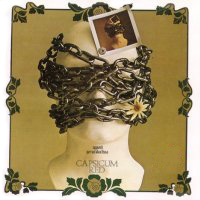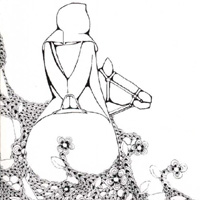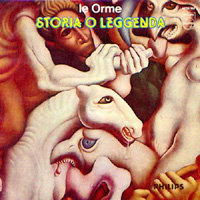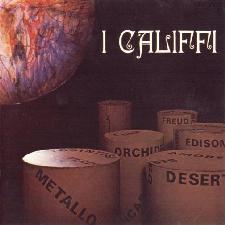 On this
page we return to the Itaprog classics – with a vengeance. The music
of Sensitiva Immagine was originally made available in 1977 on a privately
packaged cassette tape with the title, E tutto comincị coś. More
than anything else, this unaccustomed medium reflected the dire straits
into which Itaprog had now ridden. Evidently the band opted for this relatively
inexpensive solution as they believed it unlikely that a recording contract
would materialize in such an unfavorable climate. In addition, the performances
are not entirely in tune, and the listener deduces that this unfortunate
effect – not unknown, actually, among the acknowledged classics of
Itaprog – is primarily a result of underproduction. In other words,
if the defects of the product are unusually visible, we should attribute
that circumstance to its undoctored state. All of these circumstances
are more or less reflected in the nature of the music, with its advanced
progressive format, including a variety of interesting and unexpected
tempo changes, and its melancholic atmosphere. The miraculous thing is
that it represents the furthest advance of 70s Itaprog in compositional
terms. Given its fundamental position in the history of Italian popular
music, therefore, a ribbon of classic status can be pinned upon it happily.
On this
page we return to the Itaprog classics – with a vengeance. The music
of Sensitiva Immagine was originally made available in 1977 on a privately
packaged cassette tape with the title, E tutto comincị coś. More
than anything else, this unaccustomed medium reflected the dire straits
into which Itaprog had now ridden. Evidently the band opted for this relatively
inexpensive solution as they believed it unlikely that a recording contract
would materialize in such an unfavorable climate. In addition, the performances
are not entirely in tune, and the listener deduces that this unfortunate
effect – not unknown, actually, among the acknowledged classics of
Itaprog – is primarily a result of underproduction. In other words,
if the defects of the product are unusually visible, we should attribute
that circumstance to its undoctored state. All of these circumstances
are more or less reflected in the nature of the music, with its advanced
progressive format, including a variety of interesting and unexpected
tempo changes, and its melancholic atmosphere. The miraculous thing is
that it represents the furthest advance of 70s Itaprog in compositional
terms. Given its fundamental position in the history of Italian popular
music, therefore, a ribbon of classic status can be pinned upon it happily.
 Capsicum
Red’s Appunti per un’idea fissa is quite a different
kettle of fish in that it comes to us from the dawn of Itaprog –
recorded in 1971, released in 1972 – and suffers from its own peculiar
sound problem. The master tapes were destroyed, and CD editions have had
to be produced from LP copies. I’ve heard tracks from the better
of the two CD editions, and there is clearly still an aural problem, as
the second LP side starts out muffled, with some extraneous sound entering
as well – very strange! The album is renowned for its first track,
a 15-minute rock rendition of Beethoven’s piano sonata, Pathétique,
with some strong improvisational interplay between the four performers.
This is certainly one of the most eminent of the many Pathétique
adaptations in popular music, beating out Latte E Miele’s hands down.
The second side is then given over to compositions by Red Canzian, who
apparently lent his nickname to the group, although the keyboardist Mauro
Bolzan is the most prominent of the performers. Only towards the end does
a Pathétique motif return. These compositions are not especially
ear-catching, but they represent an intellectual development of the music
and invite the listener to consider the overall construction.
Capsicum
Red’s Appunti per un’idea fissa is quite a different
kettle of fish in that it comes to us from the dawn of Itaprog –
recorded in 1971, released in 1972 – and suffers from its own peculiar
sound problem. The master tapes were destroyed, and CD editions have had
to be produced from LP copies. I’ve heard tracks from the better
of the two CD editions, and there is clearly still an aural problem, as
the second LP side starts out muffled, with some extraneous sound entering
as well – very strange! The album is renowned for its first track,
a 15-minute rock rendition of Beethoven’s piano sonata, Pathétique,
with some strong improvisational interplay between the four performers.
This is certainly one of the most eminent of the many Pathétique
adaptations in popular music, beating out Latte E Miele’s hands down.
The second side is then given over to compositions by Red Canzian, who
apparently lent his nickname to the group, although the keyboardist Mauro
Bolzan is the most prominent of the performers. Only towards the end does
a Pathétique motif return. These compositions are not especially
ear-catching, but they represent an intellectual development of the music
and invite the listener to consider the overall construction.
 I have
seen it suggested that Celeste recorded their album, Principe di un
giorno, in 1974. I’m not so sure about that. It came out in 1976
on the Grog label, and it was not the first Grog release, albeit the first
classic album on that label. The sound is so refined that one can scarcely
believe it lay in the vaults for so many months. One also wishes to believe
that it was recorded in happy circumstances, given the level of accomplishment
reflected in the performances. But perhaps that is not so. We have little
or no information on why Vittorio De Scalzi’s Magma label folded
early in 1976, or how he was able to set up Grog long enough to publish
the handful of distinguished recordings that come down to us on this label.
The financial impact of the New Trolls’ court case on the progressive
rock industry may never be known, for the details of that case are hazy
enough in themselves. The music of Celeste reflects none of this, but
it is indeed a long way from standard progressive rock. Only a handful
of passages show conventional instrumentation. Persistent rhythms and
tonalities signal it as rock music, as does the use of mellotron and synthesizer.
But a good part of the vocabulary is drawn from classical, avantgarde
and folk music.
I have
seen it suggested that Celeste recorded their album, Principe di un
giorno, in 1974. I’m not so sure about that. It came out in 1976
on the Grog label, and it was not the first Grog release, albeit the first
classic album on that label. The sound is so refined that one can scarcely
believe it lay in the vaults for so many months. One also wishes to believe
that it was recorded in happy circumstances, given the level of accomplishment
reflected in the performances. But perhaps that is not so. We have little
or no information on why Vittorio De Scalzi’s Magma label folded
early in 1976, or how he was able to set up Grog long enough to publish
the handful of distinguished recordings that come down to us on this label.
The financial impact of the New Trolls’ court case on the progressive
rock industry may never be known, for the details of that case are hazy
enough in themselves. The music of Celeste reflects none of this, but
it is indeed a long way from standard progressive rock. Only a handful
of passages show conventional instrumentation. Persistent rhythms and
tonalities signal it as rock music, as does the use of mellotron and synthesizer.
But a good part of the vocabulary is drawn from classical, avantgarde
and folk music.
 The several
Le Orme albums from the second half of the 70s are not especially well known.
The group announced the addition of guitar to their complement with an album
recorded in Los Angeles, yet without any intention of breaking out of the
Italian scene. By the time of Storia O Leggenda (1977) two tendencies
were clear: the guitar was fully integrated, and the band was determined
to strive towards a pure style without heavy electronics. Soon the purist
tendency would lead to a studious, avantgarde style that essentially lay
beyond progressive. There is no need to stack the records up against each
other and decide which is best, but one can see that conditions for an interesting
and refined progressive album preexisted for Storia O Leggenda. Le
Orme did not disappoint. The conceptual ideas convey plenty of insight,
but they are now more personal and prosaic, which conforms with the shift
toward more unitary compositions with less visible continuity among them
(as reflected in the title of their preceding album, Verità Nascoste).
The record is sometimes seen as a lesser one, but that viewpoint probably
results from either a lack of perspective or a disquieting sensation due
to the unaccustomed sobriety (actually quite illusory) that is also unameliorated
by gimmickry.
The several
Le Orme albums from the second half of the 70s are not especially well known.
The group announced the addition of guitar to their complement with an album
recorded in Los Angeles, yet without any intention of breaking out of the
Italian scene. By the time of Storia O Leggenda (1977) two tendencies
were clear: the guitar was fully integrated, and the band was determined
to strive towards a pure style without heavy electronics. Soon the purist
tendency would lead to a studious, avantgarde style that essentially lay
beyond progressive. There is no need to stack the records up against each
other and decide which is best, but one can see that conditions for an interesting
and refined progressive album preexisted for Storia O Leggenda. Le
Orme did not disappoint. The conceptual ideas convey plenty of insight,
but they are now more personal and prosaic, which conforms with the shift
toward more unitary compositions with less visible continuity among them
(as reflected in the title of their preceding album, Verità Nascoste).
The record is sometimes seen as a lesser one, but that viewpoint probably
results from either a lack of perspective or a disquieting sensation due
to the unaccustomed sobriety (actually quite illusory) that is also unameliorated
by gimmickry. There are
hundreds of Itaprog albums from the 70s, mostly from 1972-6, with a few
stragglers up until the early 80s. There would be a successful Italian revival
of progressive rock in the late 80s, and numerous bands since then have
provided their artifacts to a willing audience. This latter development
is often referred to disparagingly as neo-prog, but the music serves a different
purpose. It cannot compete with the global diversity of the product of the
70s, for it is basically a packaging of the more “progressive”
elements of the earlier movement. That was a time when music could experience
fleeting success if it was different, unlike today, when success seems to
depend on whether music fits into a myriad diversity of predetermined genres.
I’m not suggesting that Itaprog was thoroughly innovative. A group
like I Califfi with its one-shot prog album Fiore di metallo from
1973 projected their existence beyond the beat era in seeking a standpoint
with respect to the past. Since Califfi were hitherto pop stars, they sought
to express the progressive as a valid function of radio music. As far as
I am aware, no hits were produced, but every song on the album is a sentimental
‘hit’. The one-shot progressive groups must often have succeeded
because their personnel were hardened by the beat era.
There are
hundreds of Itaprog albums from the 70s, mostly from 1972-6, with a few
stragglers up until the early 80s. There would be a successful Italian revival
of progressive rock in the late 80s, and numerous bands since then have
provided their artifacts to a willing audience. This latter development
is often referred to disparagingly as neo-prog, but the music serves a different
purpose. It cannot compete with the global diversity of the product of the
70s, for it is basically a packaging of the more “progressive”
elements of the earlier movement. That was a time when music could experience
fleeting success if it was different, unlike today, when success seems to
depend on whether music fits into a myriad diversity of predetermined genres.
I’m not suggesting that Itaprog was thoroughly innovative. A group
like I Califfi with its one-shot prog album Fiore di metallo from
1973 projected their existence beyond the beat era in seeking a standpoint
with respect to the past. Since Califfi were hitherto pop stars, they sought
to express the progressive as a valid function of radio music. As far as
I am aware, no hits were produced, but every song on the album is a sentimental
‘hit’. The one-shot progressive groups must often have succeeded
because their personnel were hardened by the beat era.